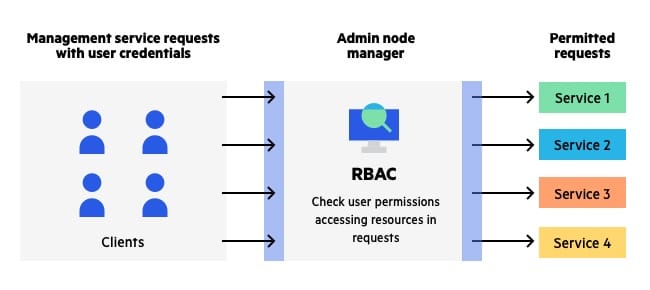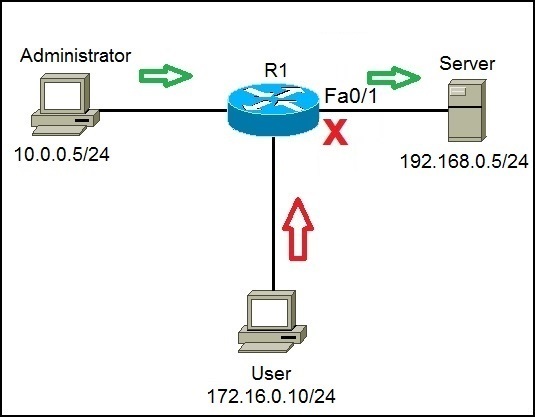Filter traffic based on IP addressing. To improve security with an ACL you can for example deny specific routing updates or provide traffic flow control.

Access Control Lists What Are Them And How To Configure
Include examples of commands to implement the ACL lists.

. ACLs containts a list of conditions that categorize packets and help you determine when to allow or deny network traffic. ACLs can permit or deny traffic based upon the MAC address originating on the router. ACLs are also used to restrict updates for routing from network peers and can be instrumental in defining flow control for network traffic.
Standard Access Control Lists ACLs are the oldest type of Access Control Lists ACL. Restrict the delivery of routing updates. The ACLS is used to filter the network traffic.
Determine Which Interfaces have ACLs. This how-to walks through a 3 step process to determining if an ACL is to blame for network issues. Filter traffic based on the type of traffic being sent.
Extended ACLs can filter network traffic based on source protocol ie IP TCP UDP etc. An Access Control List ACL is a set of rules that is usually used to filter network traffic. ACLs should be configured to control traffic from the various protocols that you may have configured in your network.
Standard IP access lists are used to permitdeny traffic only based on source IP address of the IP datagram packets. Logs created by ACLs can be useful to monitor for certain types of traffic. ACLs assist the router in determining the best path to a destination.
The ACLs can also be used for define traffic to the NAT network address translate. This property is particularly useful for internet-facing servers. In this section we will discuss the Cisco implementation of IP access control lists ACLs.
For security teams a. 23a Access control list. ACLs can be configured on network devices with packet filtering capatibilites such as routers and firewalls.
Vpc-id - The ID of the VPC for the network ACL. The primary function of ACLs is to secure the network but they are also useful for other aspects of network traffic control. Filters can be used to match a set of resources by specific criteria such as tags attributes or IDs.
The subnet mask use wildcard mask. Layer 3 ACLs operate at the network layer and filter based on layer 3 protocols and Raw IP. The data plane allows the ability to forward data packets.
Granular monitoring of the traffic exiting and entering the system. A network access control list ACLis an optional layer of security for your VPC that acts as a firewall for controlling traffic in and out of one or more subnets. These types of access list are not as powerful as extended access lists but they are less processor intensive for the router.
Layer 2 operates at the data link layer and use MAC access lists. Block specific users or traffic allowing for granular access control based on addresses protocols traffic types etc. Network ACLs are applied to network traffic at various levels of OSI model.
Extended ACL use number between 100 and 199 and 2000 to 2699. Limit network traffic in order to provide adequate network performance. ACLs What two functions describe uses of an access control list.
A level of security for network access specifying which areas of the servernetworkservice can be accessed by a user and which cannot. They may be used to filter traffic that is entering or leaving the router. C ACLs provide a basic level of security for network access.
The following example describes the way in which standard access lists can be used. Restricted network traffic for better network performance. ACLs are used to filter traffic based on source andor destination.
And ACLs can be used to reduce the flow of control plane bound traffic thus keeping the performance of the control plane from being compromised. Standard Access Control Lists ACLs can be created by using the access-lists IOS command. ACLs can be used for the following.
Also provide the steps to implement ACLs on a router switch and wireless router. Choose two a ACLs assist the router in determining the best path to a destination. Describe how ACLs can be used to control traffic.
B Standard ACLs can restrict access to specific applications and ports. Layer 4 ACLS operate at the transport layer and filter based on ports. Only allows responses for traffic that originated from within a network to return to that network.
ACLs can be somewhat difficult to troubleshoot by design they control network traffic and as a result have the ability of causing issues on the network. Standard access lists with standard access lists you can filter only on the source IP address of a packet. The three rules of configuring ACLs.
53 Describe these concepts as they relate to security monitoring. Introduction The switchis typically segmented into three planes of operation each with a clearly identified objective. If you specify multiple filters the filters are joined with an AND.
Structure A filter name and value pair that is used to return a more specific list of results from a describe operation. Provide a description of the use of Access Control Lists ACLs as a method of security on a network. Extended ACLs can filter network traffic based on destination hostname or host IP address.
An Access Control List ACL that filters IP packets based on several attributes including sourcedestination IP sourcedestination TCPUDP ports Protocol typeProtocol number. With two references at least. The main idea of using an ACL is to provide security to your network.
As I mentioned before ACLs for routers are not as complex or robust as stateful firewalls but they do offer a significant amount of firewall capability. Reasons to use an ACL. When do we use Access Control Lists.
Without it any traffic is either allowed to enter or exit making it more vulnerable to unwanted and dangerous traffic. D ACLs can permit or deny traffic based upon the MAC address originating on the router. In the extended ACL we can use the port and the protocol information and source and destination networks.
In the following examples I configure an extended ACL that deny traffic to a source IP 101001201024 headed to an host destination of 10. It can also be used to encrypt and filter non IP- protocols. ACLs can be used for the followingLimit network traffic in order to provide adequate network performance Restrict the delivery of routing updates Provide a basic level of security Filter traffic based on.
Provide a basic level of security. There are three cardinal rules that should always be observed when configuring ACLs. Network Address Translation and Port Address Translation hide internal addresses behind public IP addresses.
You might set up network ACLs with rules similar to your security groups in order to.

What Is Access Control List Acl Types Linux Vs Windows Imperva

0 Comments